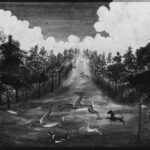Close your eyes and imagine the first snowfall in a forest from your favorite film. What are the wildlife doing? What are they preparing for? Now fast forward to the first day of spring: when all the snow melts, the grass grows greener, and the pink flowers immediately blossom. What are the wildlife doing now? If you’re picturing them preparing for winter hibernation in the first scene and emerging from their dens in the spring in the second, then you’re on the right track!
Except for one thing. Did you picture bears in that scene? Bears, and many other large mammals, don’t truly hibernate.
What REALLY is hibernation?
The Cambridge Dictionary defines hibernation as “the state of being asleep for the winter”. Another definition, from the Merriam-Webster Dictionary, is “to pass the winter in a torpid or resting state”. Finally, Dictionary.com elaborates on the definition, stating it is “an inactive state resembling deep sleep in which certain animals living in cold climates pass the winter” and continues to elaborate on some key characteristics of hibernation, which we will get to later in the article. While each definition varies slightly on length and detail, the overarching definition is prolonged inactivity during the winter months. Hibernation isn’t the only option for mammals during the winter as it is one of the forms of dormancy.
Dormancy describes the overarching state in which bodily functions slow down for a given period of time. Forms of dormancy include hibernation, torpor, winter lethargy, brumation, and estivation.
Hibernation may last longer than a day, depending on the animal. However, these animals will need to wake up once every few days to eat, increase their body temperature, and urinate or defecate. Then, they will quickly return to their hibernation state. This is why you may see a squirrel hopping around on the snow in the winter. Animals that undergo this behavior are referred to as “true hibernators”. These include ground squirrels, marmots, and hedgehogs. Marmots are the largest mammal (weighing between 6 and 15.5lbs) to undergo true hibernation.
Torpor, or daily torpor, a shorter version of hibernation where bodily functions and body temperatures still decrease, but not nearly as much or for as long. In torpor, animal body temperatures decline to around 64?F, whereas in true hibernation, body temperatures can drop as low as 41?F. Torpor typically lasts less than one day, but is still different from sleep because of the physiological changes associated with it. When we sleep, our body temperature can only decrease by approximately 2?F! A great example of mammals that undergo torpor during winter are bats, or birds like the ruby-throated hummingbird.
Large mammals, like bears, undergo winter lethargy. A bear’s body temperature declines to around 88?F and can stay inactive for months before arousing, or waking. Since bear body temperatures do not decrease as much as those that undergo torpor or true hibernation, it takes less time to resume normal behavior following winter lethargy. Bears will remain in winter lethargy for months at a time and do not need constant wakening like true hibernators.
Reptiles and amphibians h
Reptiles and amphibians have adapted for the winter months through the process of brumation. Reptiles and amphibians are ectotherms (cold-blooded) and cannot regulate their own body temperatures, like mammals do through homeostasis. Instead, they rely heavily on outside temperatures. Reptiles and amphibians will be in this state for months and arise occasionally to eat, drink,, or to urinate or defecate. Studies have shown reptilian metabolic rates decrease during brumation, but there is still plenty of research to be done regarding the physiological changes reptiles and amphibians undergo in this state.
The final form of dormancy is estivation, a behavioral response to extreme warm temperatures instead of cold winter temperatures. Estivation can be experienced by invertebrates (e.g., worms or mollusks), reptiles, amphibians, and small mammals (including the fat-tailed lemur, African four-toed hedgehog, kangaroo rats, and pocket mice). Estivation allows animals to conserve energy and water in extremely high temperatures by decreasing their metabolic rate. In short, estivation is the warm-weather equivalent to hibernation!
| Animal | Type of Dormancy | Physiological Changes | Duration |
| Hibernation | · Undergone in extremely cold conditions · Decreased metabolic rate by ~5% · Body temperature approximately 41?F | · Lasts ? 1 day · Wake up every few days | |
| Daily Torpor | · Undergone in extremely cold conditions · Decreased metabolic rate by ~30% · Body temperature as low as 64?F | · Lasts ? 1 day · Wakes up every day | |
| Winter Lethargy | · Undergone in extremely cold conditions · Decreased metabolic rate by 50-60% · Body temperature as low as 88?F | · Lasts weeks to months · Rarely to never wakes | |
| Brumation | · Primarily undergone by reptiles and amphibians · Begins when weather between 50 and 60?F | · Lasts weeks to months · Wake up every few days | |
| Estivation | · Undergone in extremely warm conditions · Decreased metabolic rate 70-80% | · Lasts weeks to months · Wake up every few days |
Ready, Set… Hibernate?
Many films and shows depict wildlife preparing for dormancy, but refer to it as hibernation. Likely, this is based on the amount of time the animal disappears during the winter instead of the physiological changes. Bears fit perfectly into that scenario since they remain hidden in their dens for months on end until they finally emerge when temperatures increase. But remember, it would be too costly for such a large bear (black bears, depending on sex, can range from 130 to 660 lbs) to decrease their body to such a low temperature. Imagine how long it would take for them to warm up, like how long it takes you to warm your whole body just from drinking hot chocolate, coffee, or tea. So, the next time you hear someone asking why a squirrel was spotted in the middle of December, you can say, “It actually isn’t that weird to see grey squirrels in the winter”.
About the Author
Hello, my name is Justine Smith and I am a Master's student in the Warnell School of Forestry and Natural Resources at UGA. My study focuses on the use of passive camera surveys on private agricultural properties to observe the impact wild pigs have on native plants and animals, and quantify damage to crops associated with the species. I am originally from New Jersey and am slowly but surely acclimating to the intense Georgia heat. When I'm not looking at photos from my cameras, I can be found reading books on the back porch, playing video games, or exploring the woods for some discarded treasures to take home, like deer antlers. Contact me at: justine.smith@uga.edu
- Justine Smithhttps://athensscienceobserver.com/author/justine-smith/October 23, 2024
- Justine Smithhttps://athensscienceobserver.com/author/justine-smith/
- Justine Smithhttps://athensscienceobserver.com/author/justine-smith/December 4, 2021








